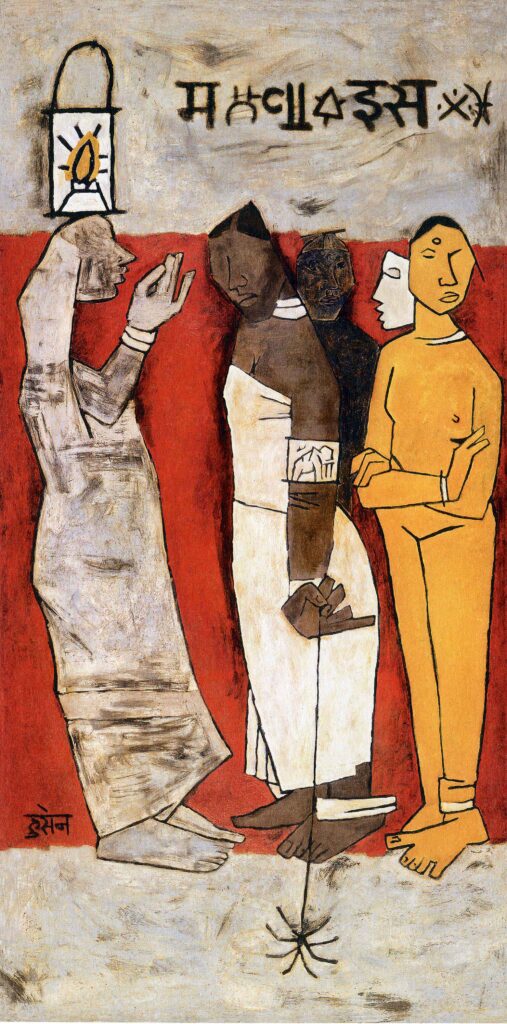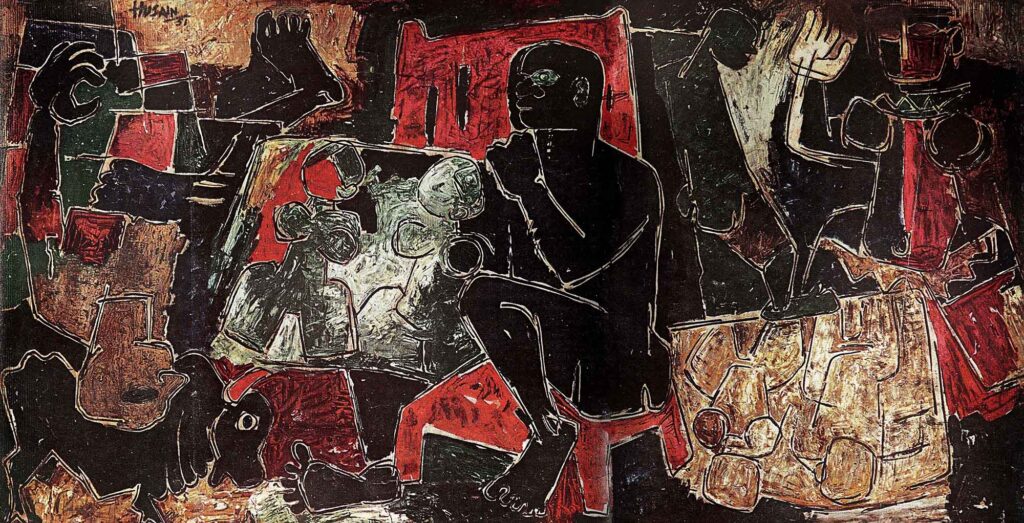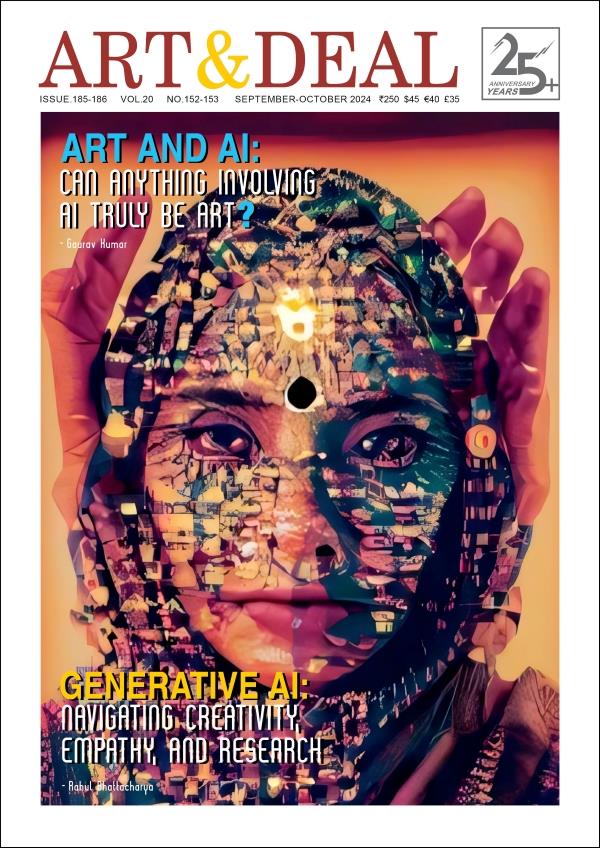
96 x 48 inches, Oil on Canvas, 1956,
Image Courtesy: AstaGuru Auction House
Maqbool Fida Husain, an artistic luminary whose name resonates through the corridors of Indian art history, emerged from the temple town of Pandharpur, Maharashtra, on September 17, 1915. Little did the town foresee that within its sacred embrace, a creative force was being nurtured that would shape the trajectory of Indian art on both national and international stages.
Pandharpur, with its grand Vithoba Temple, was a town steeped in religious fervour. It was here that Husain’s family, part of a small Muslim community, seamlessly blended into the cultural tapestry of the town. The loss of his mother at a young age left an indelible mark on Husain, influencing his art as he sought to fill the void through his creations. His grandfather, a tinsmith, played a pivotal role in his upbringing, and the imagery of lamps and umbrellas from those early days found a recurring place in his artwork.
Indore, where the family later moved, became a crucial backdrop for Husain’s artistic evolution. The cultural confluence of Indian traditions and British influence during the British Raj fascinated him, inspiring his later “Raj Series.” His exposure to Indian classical music and Dhrupad performances, along with visits to a farrier with his grandfather, laid the foundation for the intricate representation of horses in his paintings.
His artistic journey truly commenced when he encountered N.S. Bendre, a respected painter in Indore. Bendre’s influence shaped Husain’s early artistic endeavours, leading him to enrol in the Indore School of Arts. However, he soon realised that art was not about mere replication but a gateway to a realm beyond words, allowing artists to communicate emotions and ideas intuitively.
In 1934, Husain’s pursuit of art brought him to the Sir J. J. School of Art in Bombay, but financial hardships forced him to return to Indore temporarily. His resilience, however, brought him back to the vibrant streets of Bombay in 1936. Living on pavements near Grant Road Station, Husain’s determination and innate talent were his only assets.

His foray into cinema hoarding painting and later designing nursery furniture showcased Husain’s versatility. His keen eye for innovation allowed him to develop a unique method of enlarging images rapidly. While designing furniture, he injected classical Indian motifs and imaginative interiors, reflecting his concern for children’s safety.
The year 1947 marked a pivotal moment in Husain’s life and the broader narrative of Indian modernism. Leaving a secure job at Fantasy Furniture, he submitted works at the 1947 Bombay Art Society exhibition, winning an award for his painting ‘Sunehra Sansar.’ This bold move aligned with the birth of the Progressive Artists’ Group (PAG) led by F.N. Souza, becoming a cornerstone in Husain’s journey.
The PAG, a rebellion against established artistic norms, welcomed Husain in 1948. His journey with PAG, marked by a visit to the Rashtrapati Bhavan exhibition and exposure to Indian classical art, steered him towards a profound understanding of Indian aesthetics. The vibrant hues of Basohli miniatures and the bold strokes of Chinese calligraphy left an indelible mark on his artistic psyche.
Husain’s diverse influences from 1948 to 1953, ranging from Gupta sculptures to Western masters like Cezanne and Picasso, converged in the cauldron of his mind. The 1950s witnessed the emergence of Husain as a major artist on the global stage, with exhibitions in Paris, Venice, São Paulo, and Tokyo.
The 1950s and 1960s marked a thematic evolution in Husain’s art. While societal unrest did not overtly influence his canvases, his focus shifted to the female form, becoming an embodiment of emotions and desires. Sensuality and exploration of the depths of human passion defined this period.
As the 1960s transitioned into the 1970s, religion emerged as a prominent motif in Husain’s art. Drawing inspiration from Indian epics and global faiths, he created ‘Theorama,’ a ten-panel series celebrating religious diversity. Animals, especially horses, bulls, and tigers, frequently took centre stage, reflecting the symbiotic relationship between humanity and the animal kingdom.
Husain’s exploration of sensuality, spirituality, and the beauty of creatures left an indelible mark on the art world. His ability to transcend societal boundaries and capture the essence of his subjects with reverence and vitality made him a true visionary. As the art world continues to evolve, M.F. Husain’s legacy remains a testament to the enduring power of creativity and the timeless beauty of the human and natural world.
Read More>> Please Subscribe our Physical Magazine

